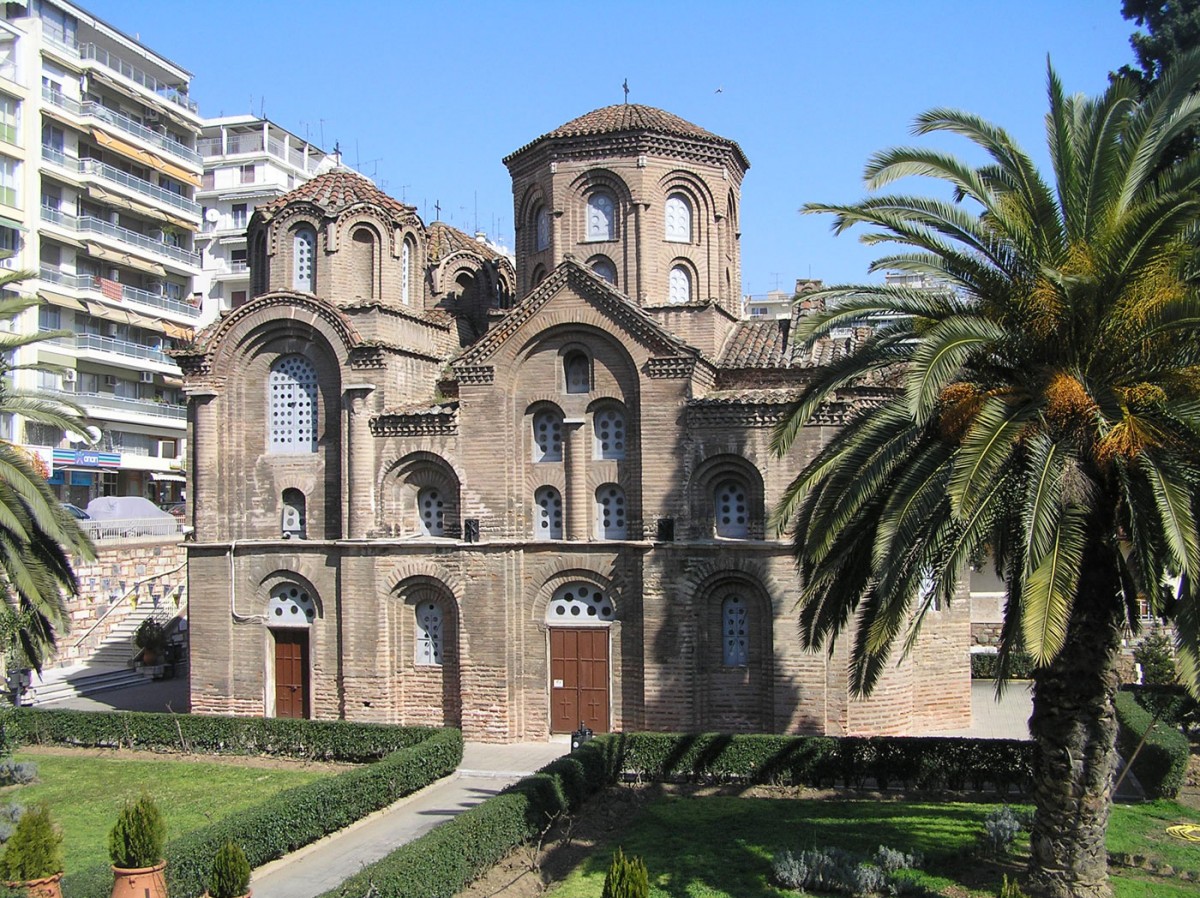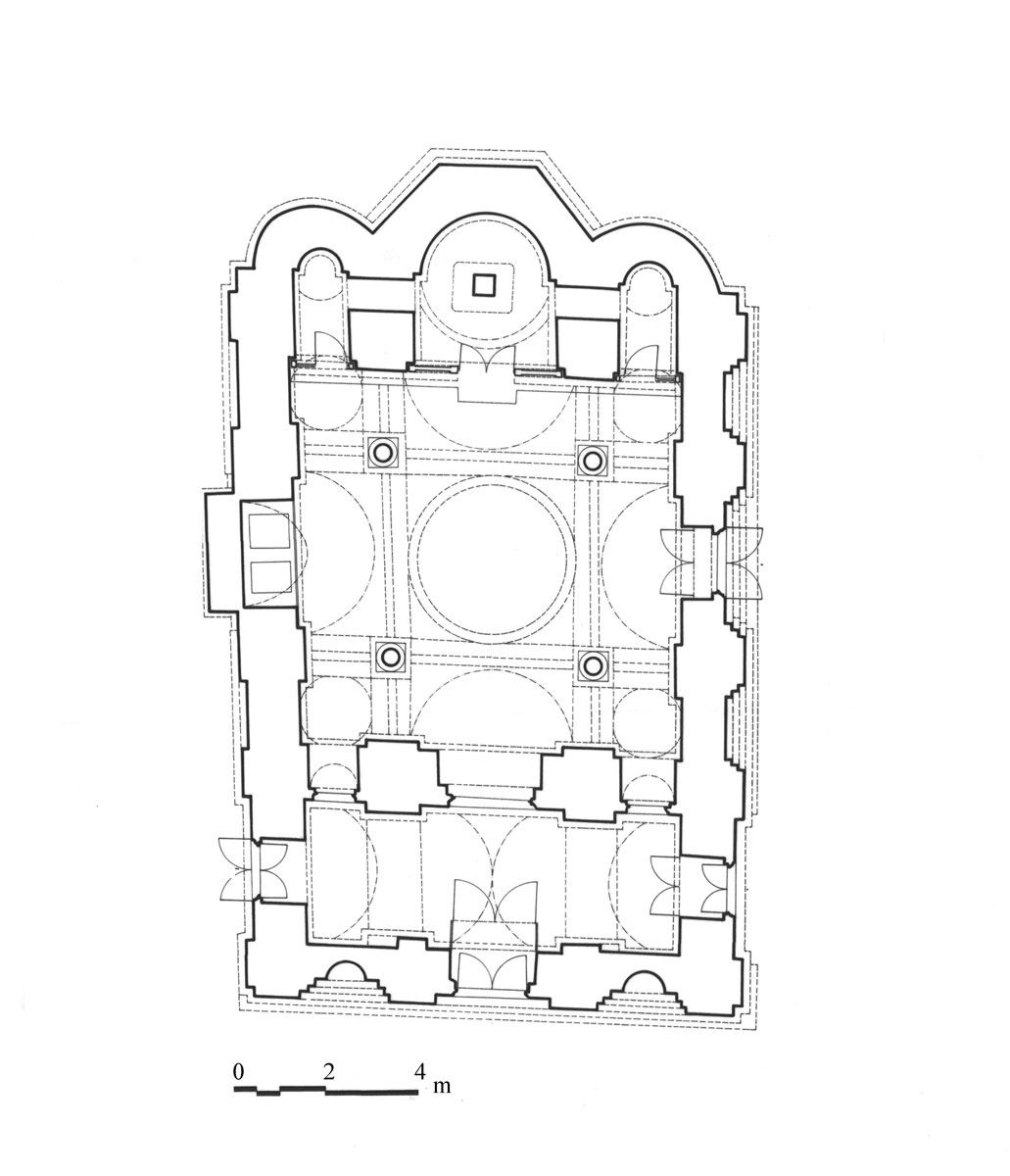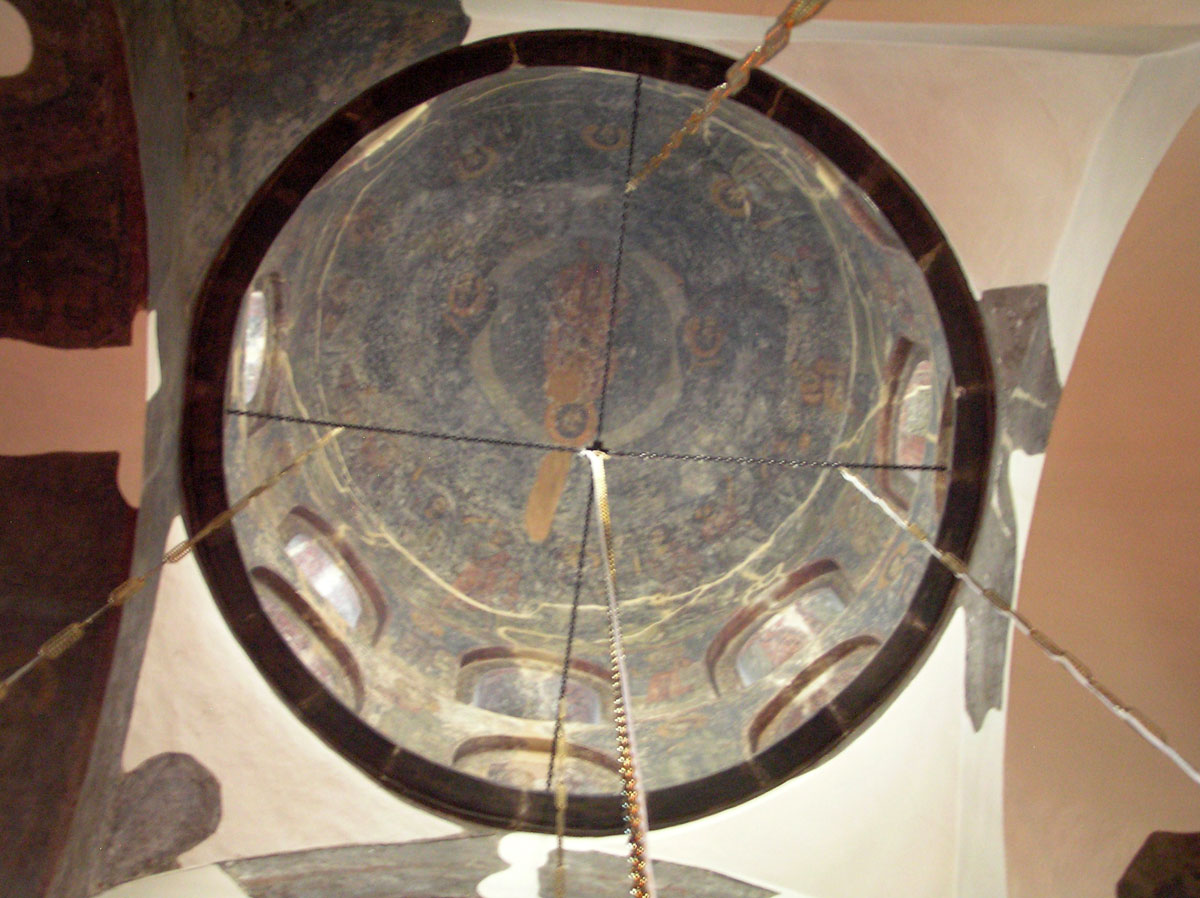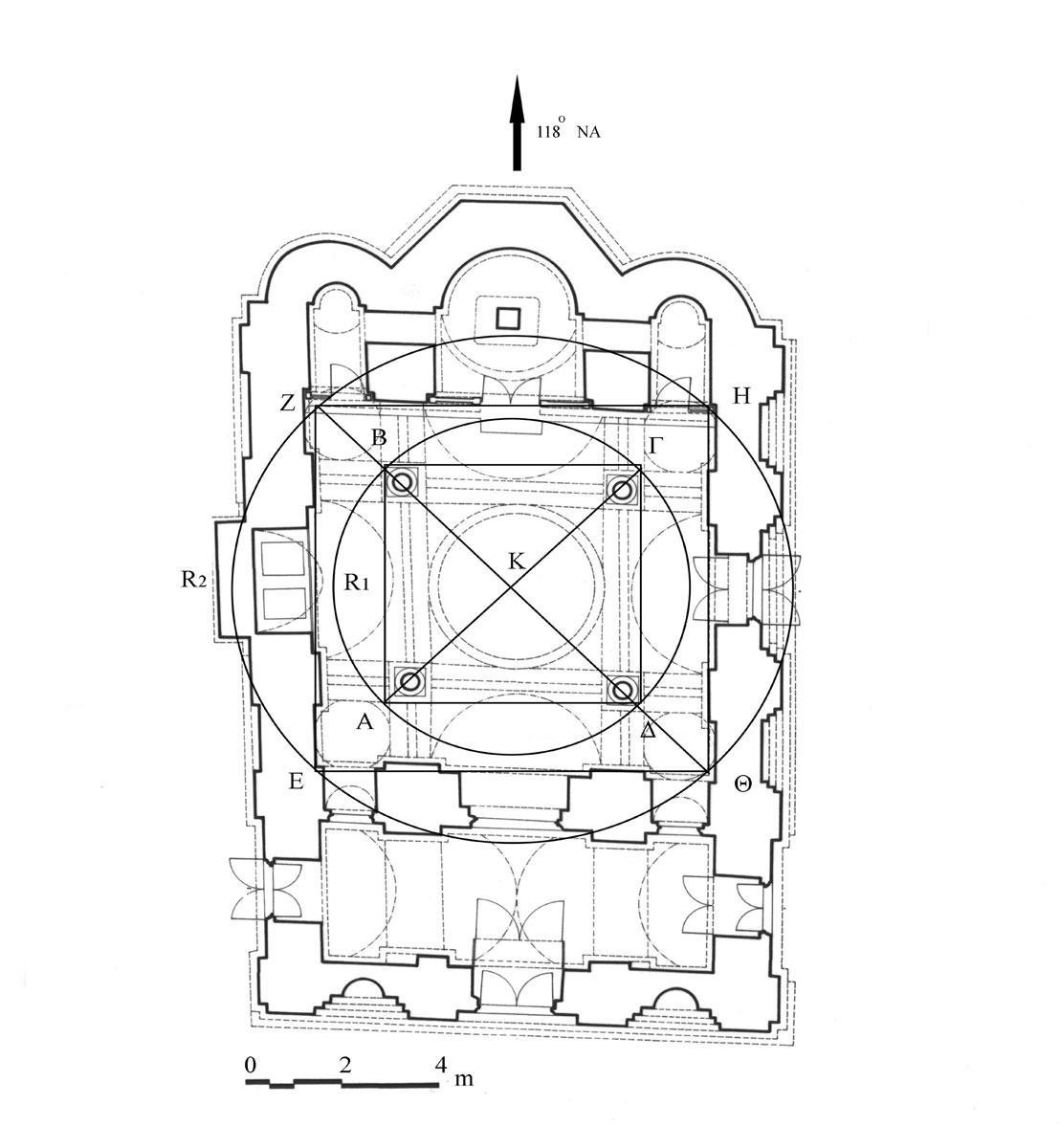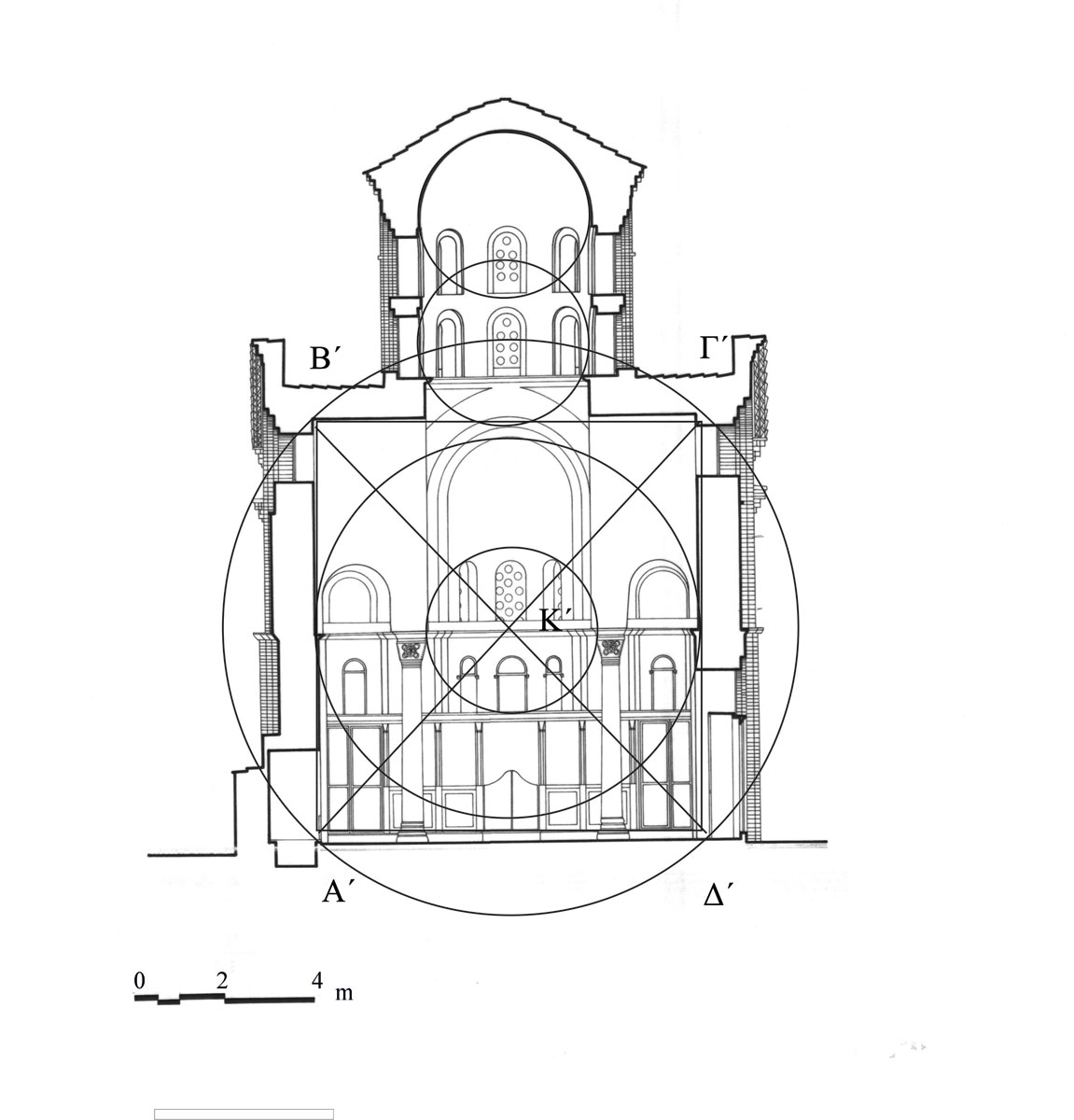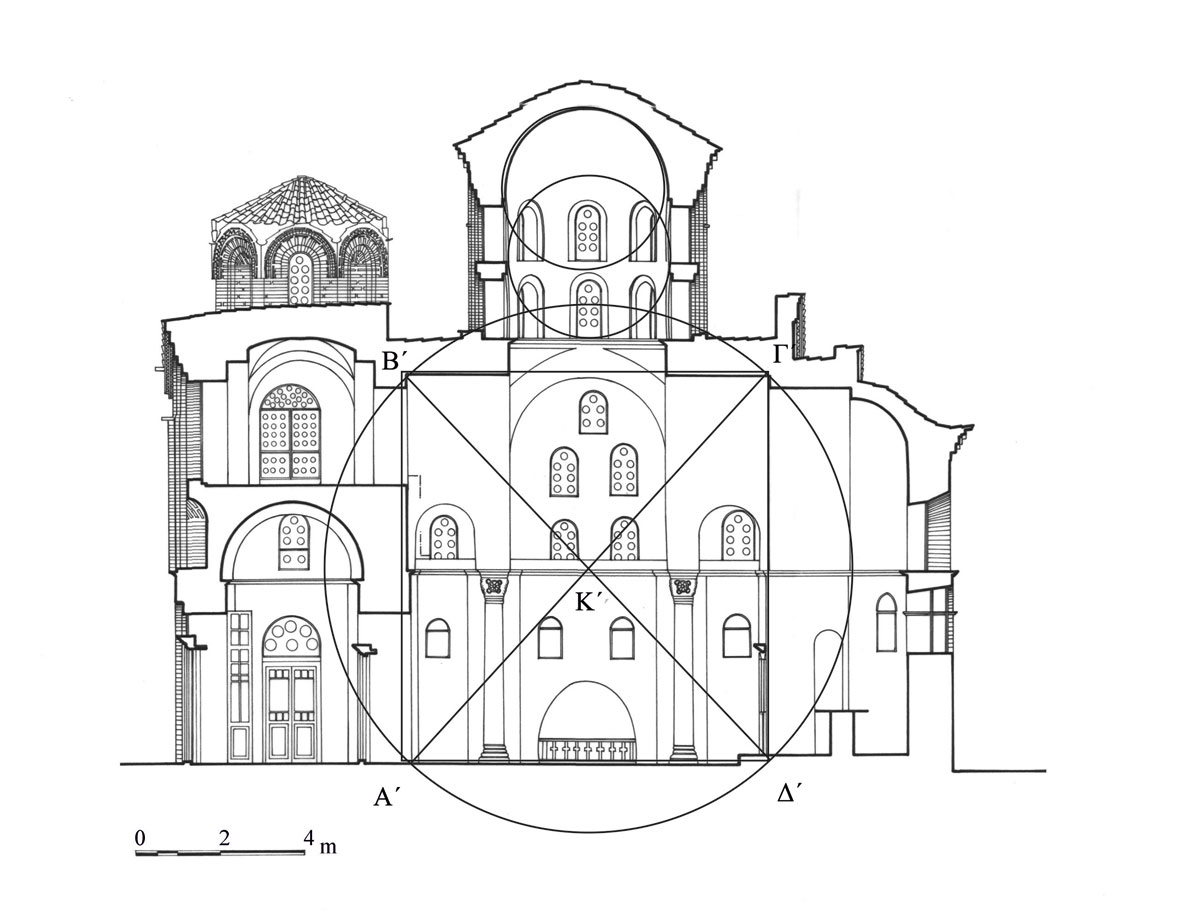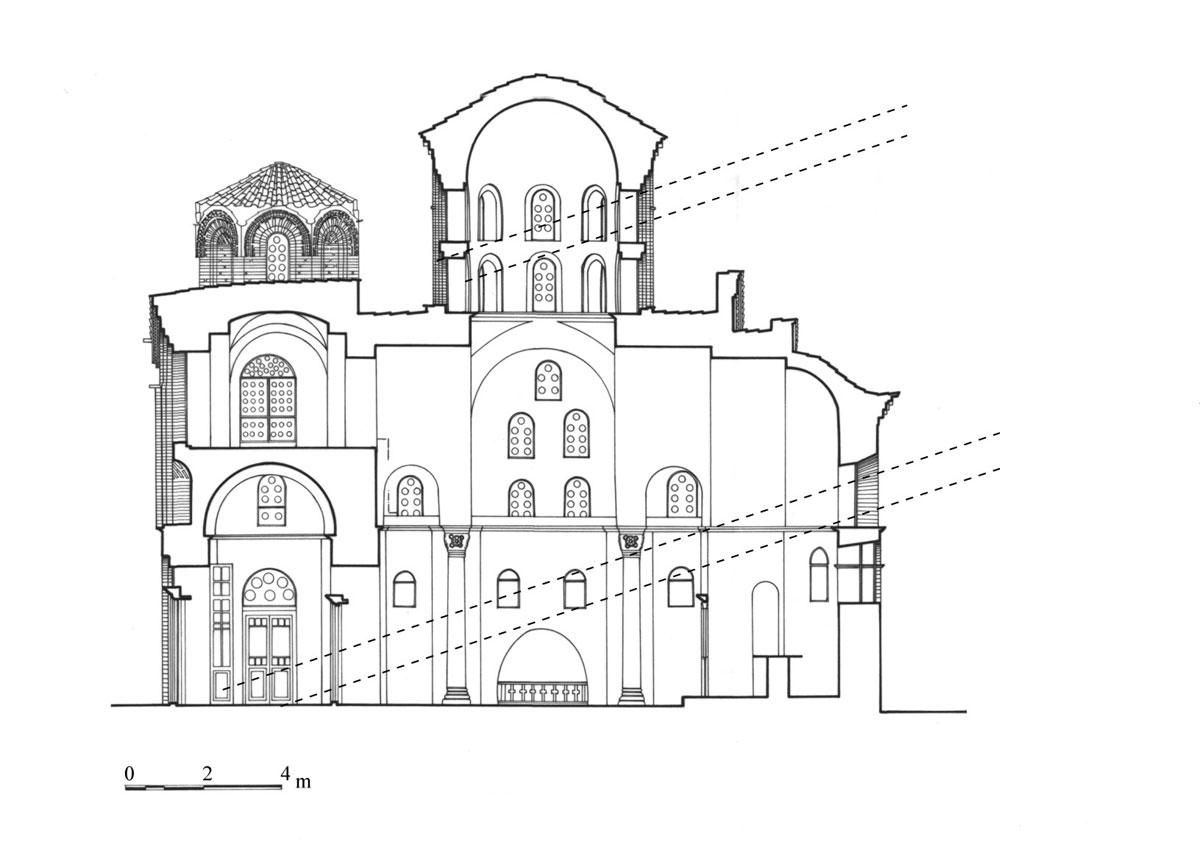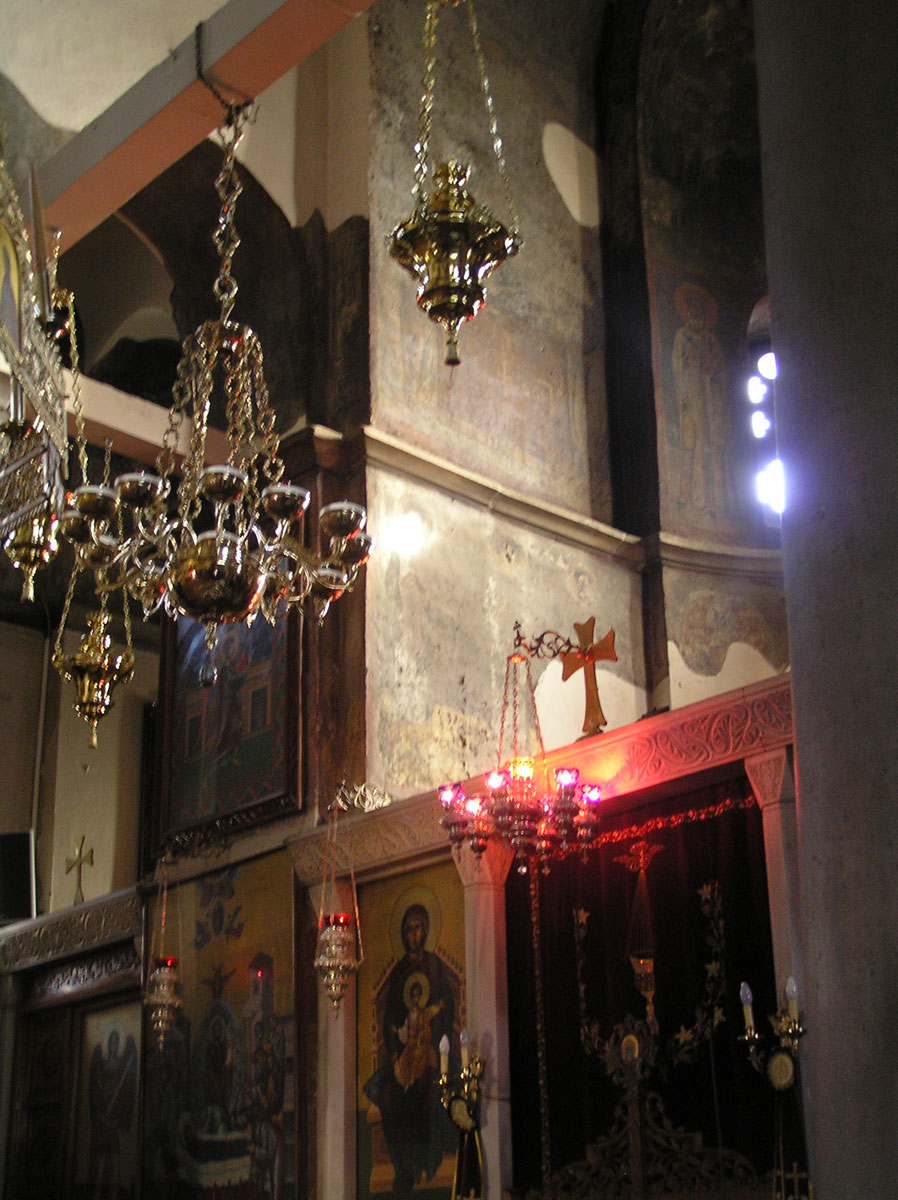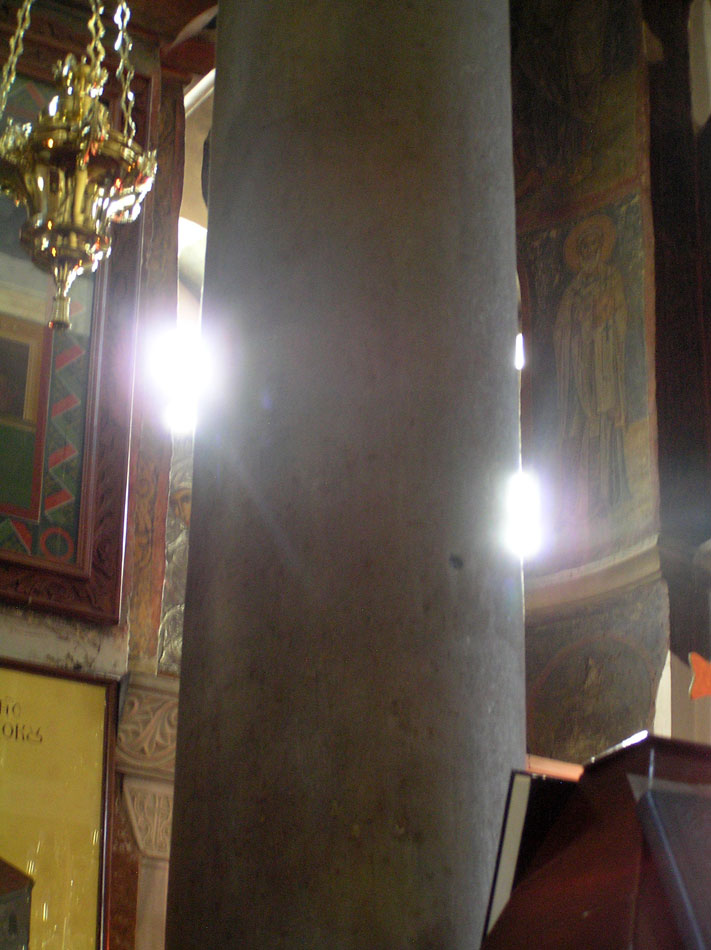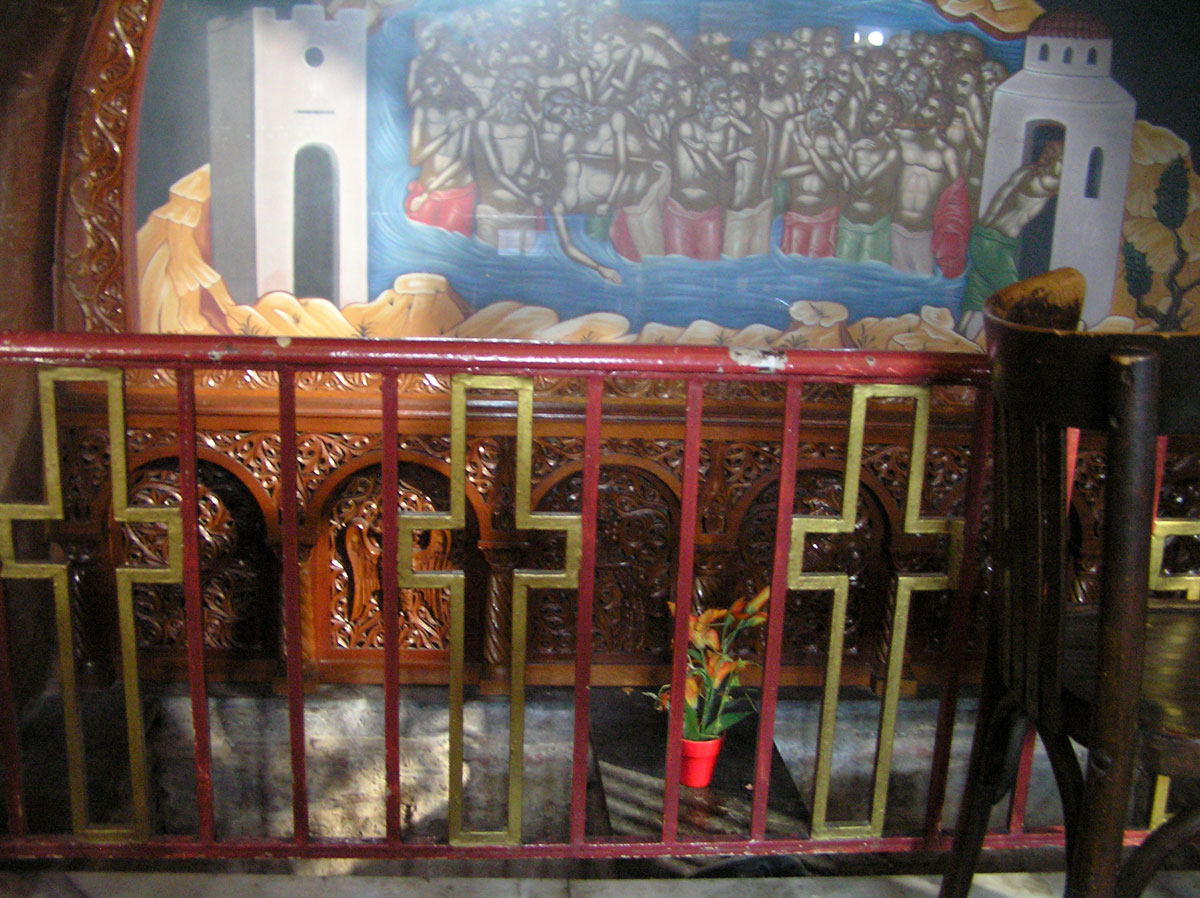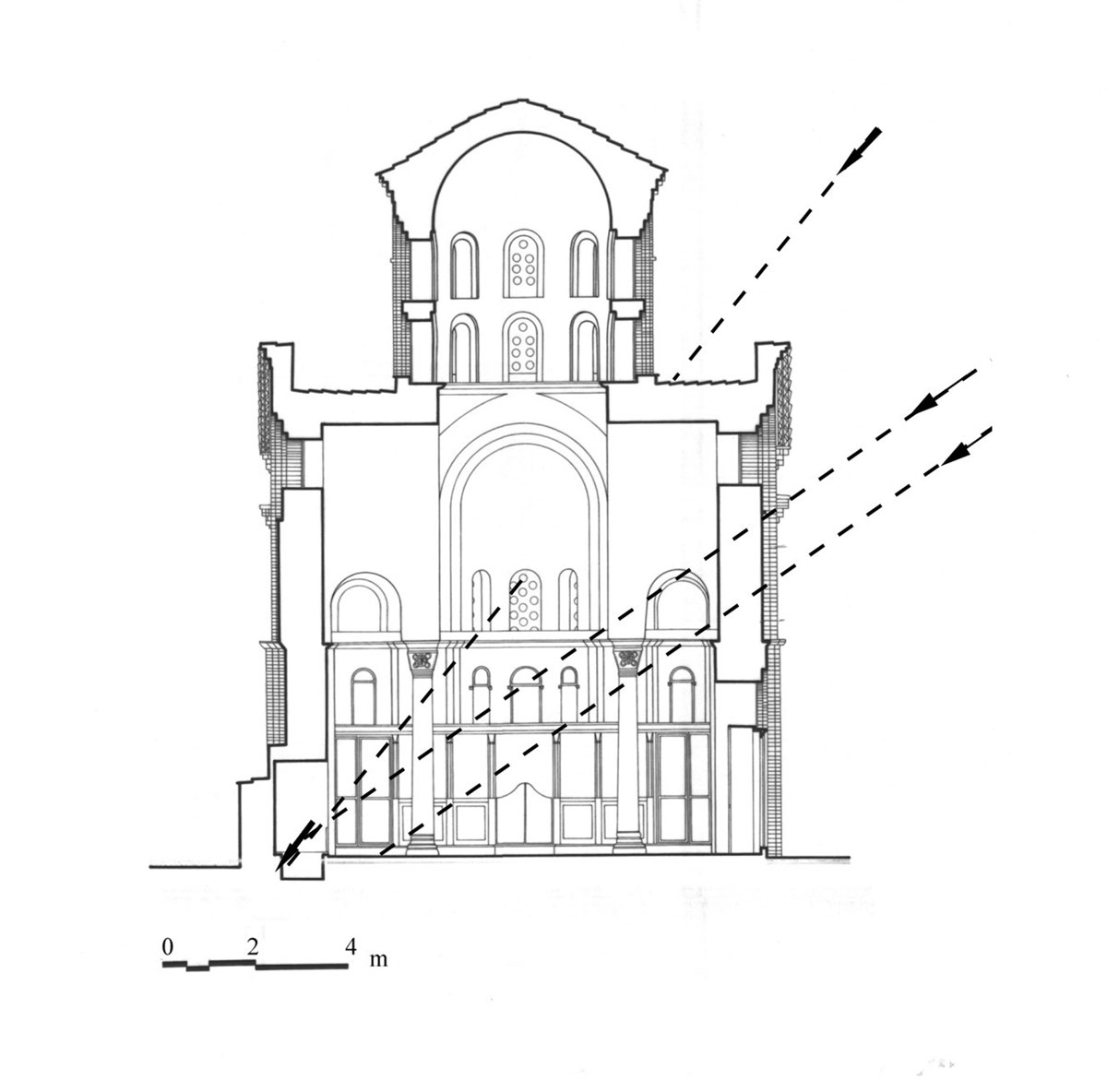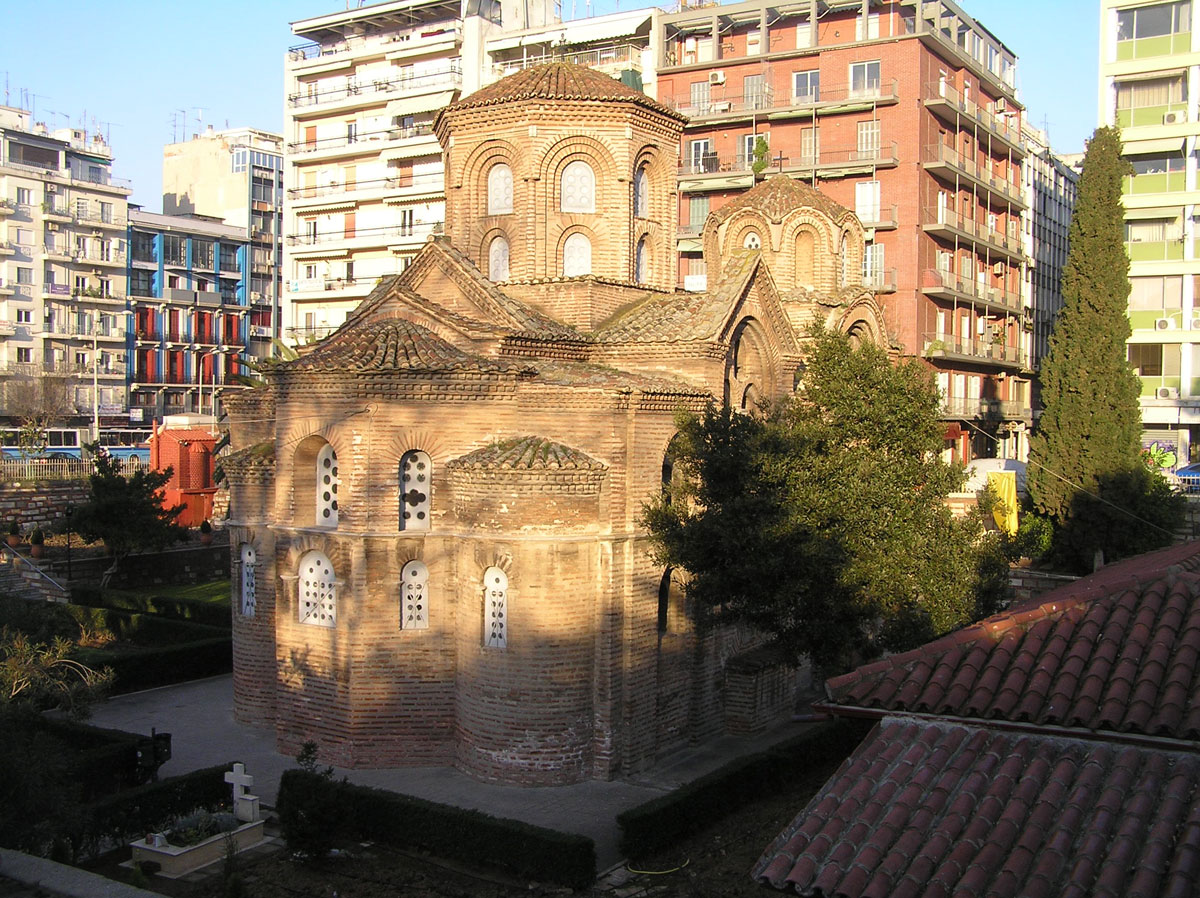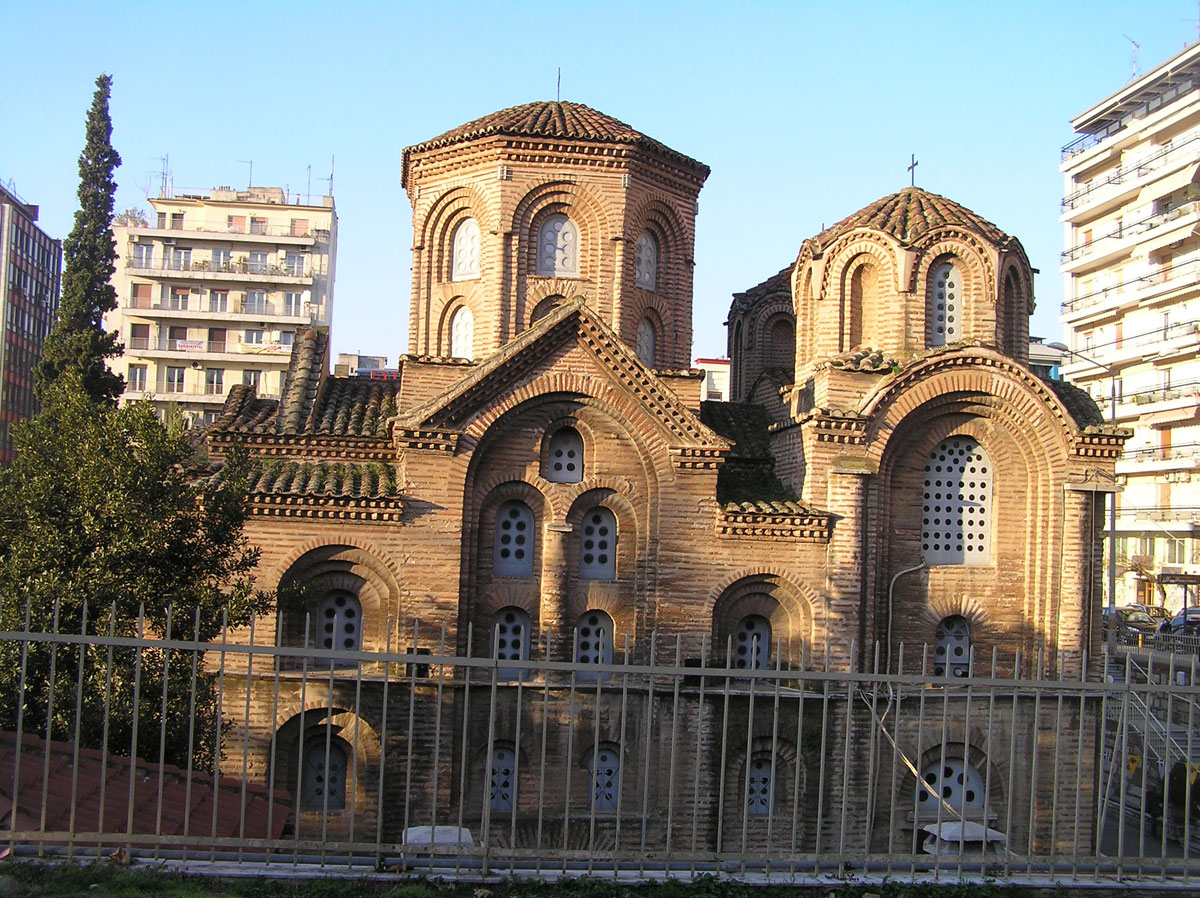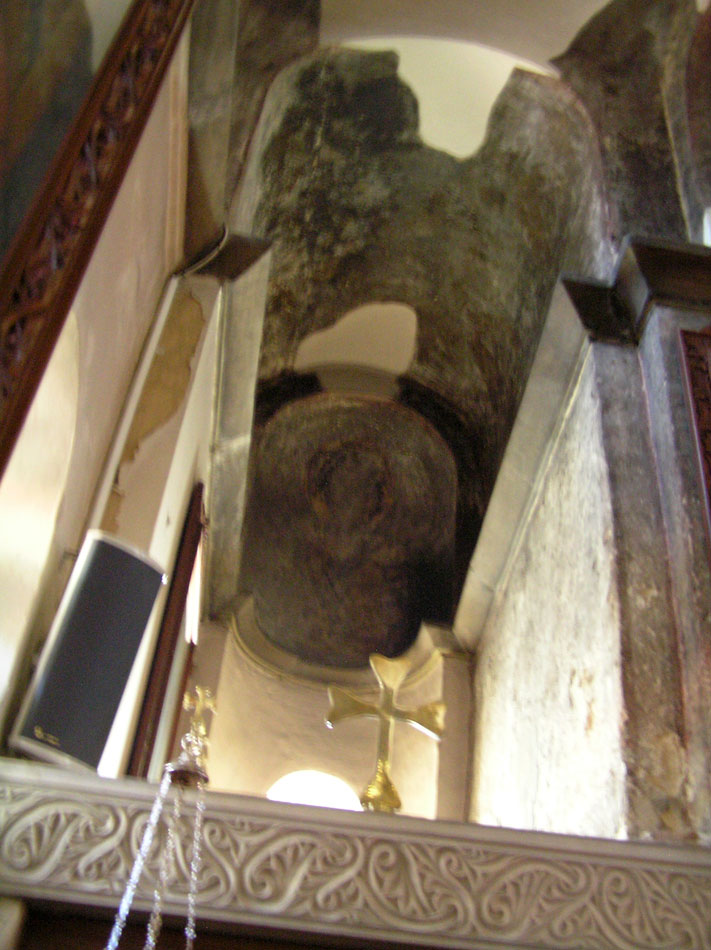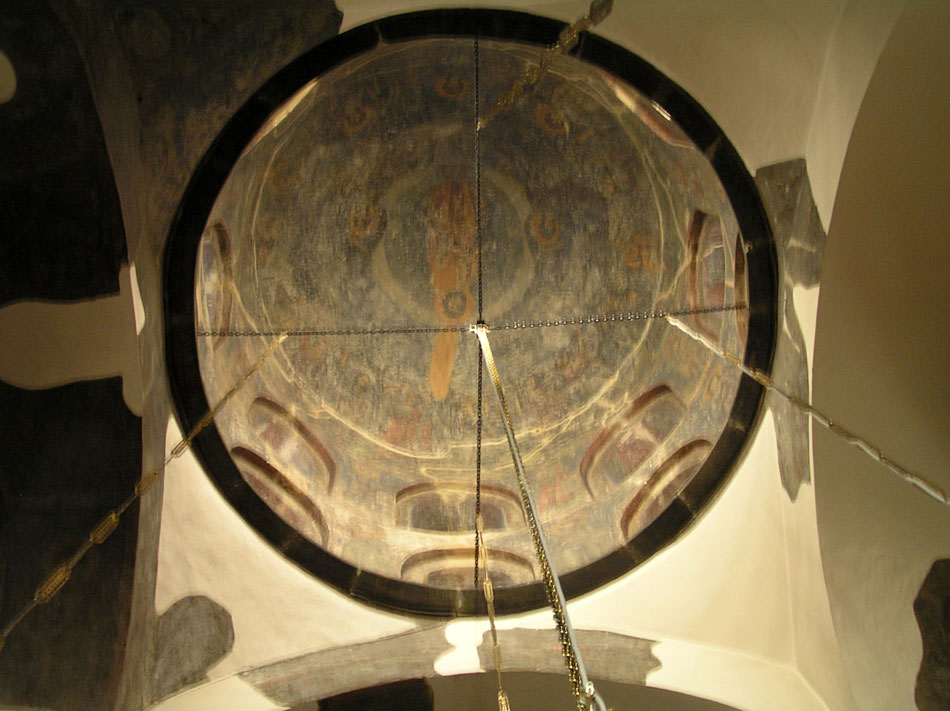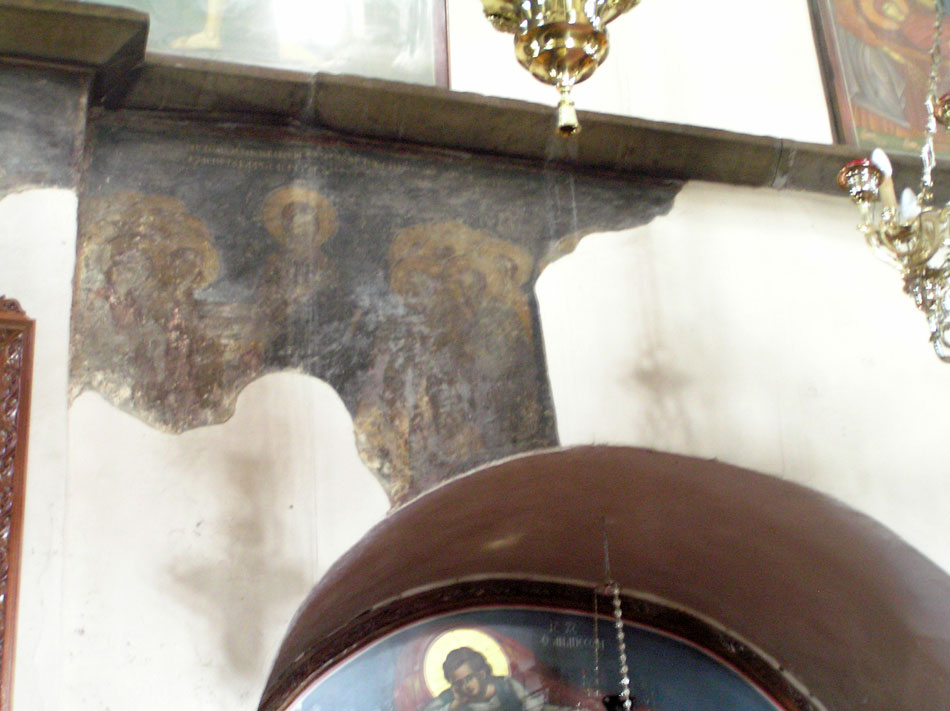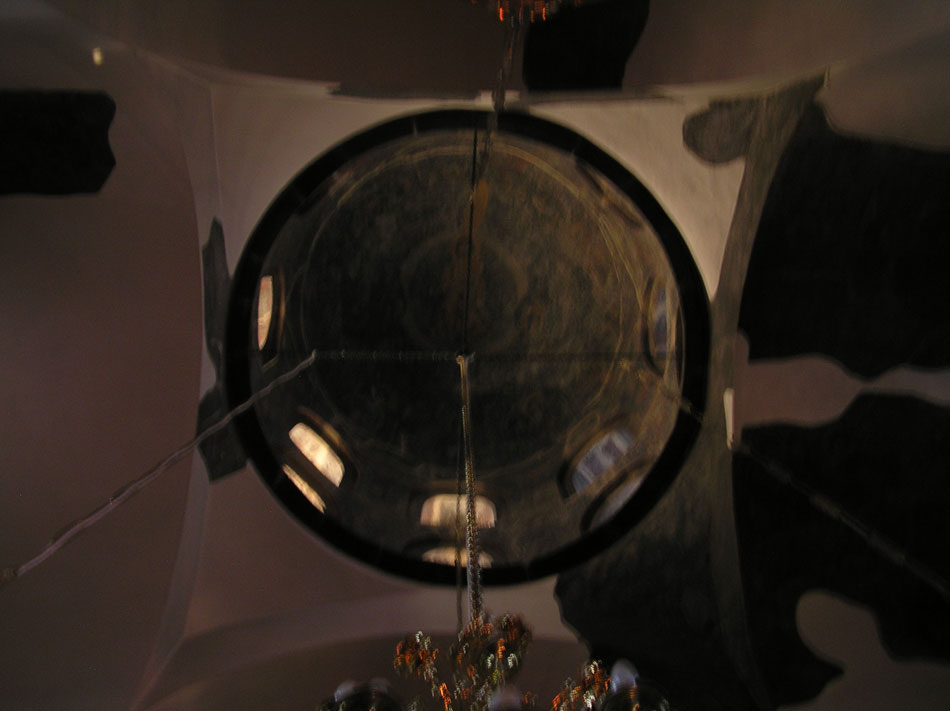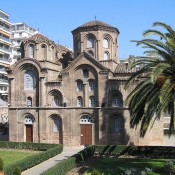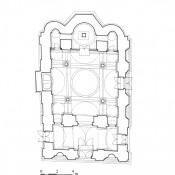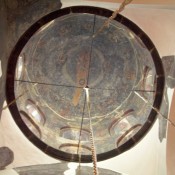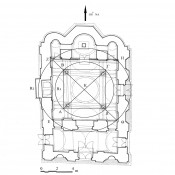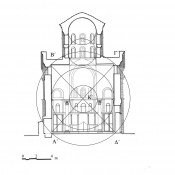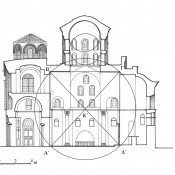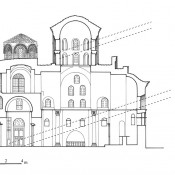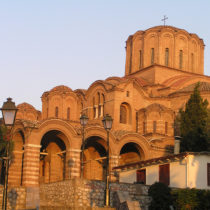The role of natural light in Byzantine church architecture is especially apparent in the catholicon of the 1152 AD monastery of the Panaghia Kosmosoteiras (note 1) in Thrace. There, at specific hours of the day throughout the year, the incoming light illuminates particular parts of the church and particular images, such as the depiction of the Annunciation and the corner compartment under the small north western dome. This spot is very possibly the location of the tomb of Isaac Komnenos, the patron/founder of the monastery.
Another example is the 14th century church of Soteros Christou (Christ the Saviour) in Thessaloniki (note 2). Having made observations and taken measurements, I came to the conclusion that the beams of light coming in through the dome windows focus on the tombs inside the church at certain times of the day and seasons of the year.
Taking these two cases as my starting point, I continued research on the role of light in the church of the Panaghia Chalkeon (note 3) of 1028 AD, in Thessaloniki. The architecture of the church is extremely interesting as it is practically the only one of that period in Thessaloniki. Moreover, the position of the founder’s tomb is interesting, being, as we know, in the centre of the church’s northern side in the form of an arcosolium. It is rare to find a tomb in this part of the church. Usually patrons’ tombs are located in the narthex or in the churches’ NW corner (note 4).
The Panaghia Chalkeon (fig. 1) is a cruciform church with a dome. Its interior is divided into the narthex, the nave and the sanctuary (fig. 2). In the nave, four columns hold up the circular base of the octagonal dome by means of arches and pendentives. On each of the dome’s sides are two successive arched windows which take up almost the entire height of each side. The windows’ axes are identical with the main and diagonal axes of the church.
The sanctuary is an independent section. Its central apse is semicircular on the inside and trilateral on the outside. On each side of the sanctuary’s apse are two successive windows while there is one in the apse of Holy Intent and one in that of the Deacon.
The nave takes up the entire width of the church. Its eastern wall has three openings with marble lintels. Above the nave is the gallery (hyperoon) which is covered by two small octagonal domes. Each small dome has a set of four arched windows aligned with the East-West and North-South axes of the church. Their height almost equals that of each side (note 5). In the centre of the east wall there is a large arched opening that faces the nave. On the three sides of the gallery there is a total of five large openings, three on the west and one on the north and south sides respectively.
In 1430 the church was converted into a mosque known as the “Kazantzilar Cami” (mosque of the coppersmiths).
After the 1978 earthquakes, work was carried out on the fixing and conservation of its wall paintings.
The Church’s orientation
The orientation of the church’s main axis is 118° (note 6). It is turned slightly east from the direction of the Egnatia highway and from the orientation of the churches situated in the town’s urban grid. The discrepancies and irregularities (note 7) observed in the building’s plan are justified by the fact of the church having been built over an earlier pagan temple (note 8).
The axes of the central windows of the sanctuary’s apse are aligned with the point on the horizon from which the sun rises in the winter (winter solstice), while the eastern windows are aligned with the East (summer solstice) and the southern ones with the South.
The Iconography plan
According to the patron’s inscription on the arch of the sanctuary, the wall paintings of the church date from its founding. Some novelties can be observed in the plan for the iconography of the Panaghia Chalkeon church, such as the depiction of the Ascension in the dome (note 9) (fig. 3). Christ’s head, in the Ascension, is turned towards the narthex, meaning that the Former’s head faces west while his body faces east. Christ is addressing his church’s congregation which as it is facing the sanctuary, can see Him correctly (note 10). Sixteen prophets are depicted below the Ascension, as well as only two surviving seraphim, out of many, in the pendentives.
The subject of the Ascension in the dome has caused much discussion. A Tsitouridou (note 11) expressed the opinion that this specific depiction was due to the monument’s funerary character.
Geometric analysis and natural light in the church’s interior
In the church’s ground plan and between the four columns (note 12) a rectangular square AΒΓΔ is formed, each side being 5 m long, inscribed in a circle with K as a centre and a radius of 3,5m (its diameter being about 7m) (fig. 4). The inside width and length of the nave is 8,3m. To our mind, it approximately forms a square ΕΖΗΘ with a 12m long diagonal. This square is inscribed in a circle with a 6m radius.
In the cross section, lengthwise and width wise, from the floor to the arches of the antennae (note 13) rectangular squares Α, Β, Γ, Δ, are formed in the nave’s interior. These are inscribed respectively in the circumferences of a circle with a 6m radius (fig. 5, 6). The centre K is shown at the height of the cornice and in the apron of the central window of the sanctuary’s apse as well as at the base of the windows of the north and south side respectively (note 14). Furthermore, the height of the church is divided into three parts: a) 4,5m from floor to cornice b) 5,5m from cornice to the dome’s base and c) 5,3m from the base of the dome to its top.
The dome is narrow and tall. Its diameter is 3,8m and its height is 5,3m. Its windows are 1,3m high and 0,69m wide. The antennae windows do not have the same dimensions. The windows in the middle row are 1,10m high and 0,60m wide, while the tallest one and the two from the first row are 1m high and also 0,60m wide. The form and dimensions of the windows in the sanctuary apse differ not only from those on the north and south side but also from each other. Due to the thickness of the masonry (1m), the height on the inside of the middle window of the second row is 1,5m while that on its outside is 1,80m. The corresponding window on the lower row has the same width, an inside height of 1,4m and an outside height of 1,60m (note 15). The windows on the upper row of the sanctuary’s apse are 6m from the church floor while the lower ones are 4m. All the apse windows are higher than the iconostasis of the sanctuary which thus facilitates the entrance of the sun beams into the church’s interior.
Although we also encounter some of these dimensions in the churches of the Palaiologian Renaissance, the basic ones of the Panaghia Chalkeon differ significantly from the 13th and 14th century churches of Thessaloniki.
Therefore, the research on the conditions of natural light and a mapping of the course of the sun beams may possibly lead us to interpret certain architectural choices that do not only become obvious through the study of the plans.
Autumn- Winter
November (23rd/ Sunrise 07:15 – Sunset 17:08)
December (3rd/ Sunrise 07:24 – Sunset 17:06)
January (19th / Sunrise 07:38 – Sunset 17:34)
February (2nd / Sunrise 07:29 – Sunset 17:49)
In the morning hours of November between 09.00 and 09.30, the sun is exactly in the direction of the church’s central axis. Rays of light come through the dome windows and move to both the tympanum and the pendentives on the west side. Due to the reflections, all of the dome is strikingly bright (fig. 6). Rays of light also come through the east windows of the sanctuary apse and reach the doorstep of the main entrance to the narthex (fig. 7). The west side beneath the cornice to the floor is “bathed” in light. These lighting conditions coincide with the reading of the Holy Bible.
At 10:30 the sun has already moved south of the central axis. The light entering through the sanctuary windows brightly illuminates the wall paintings of the nave’s west side, the north side of the apses of Holy Intent and of the Deacon as well as the central apse where there is a depiction of both the Holy Eucharist–Communion and the Apostles from the Last Judgement (fig. 8).
From 11:00 till noon the sun is in the direction of the axis of the south window of the sanctuary apse (azimuth 180º from the North).Rays of light cross over the iconostasis ,pass close to the NE column and focus/converge on the spot where the founder’s tomb is located (fig. 9, 10). The same lighting conditions are repeated during the winter.
In the afternoon the sun is in the direction of the axis positioned widthwise. Beams of light move through the south windows to the middle of the north side, illuminating the area from the bottom to the height of the cornice. The beams entering through the two lower windows of the south antenna of the cross focus on the founder’s tomb (fig. 11). At that particular moment the sun is estimated to be about 30º above the horizon (note 16).
The dome is intensely bright either in sunshine or in cloudy weather. It seems however that the sun beams are trapped in the dome area and do not direct themselves lower down towards the nave as is usual in churches (note 17).
Before sunset, the light, via the windows of the south antenna, focuses on the wall paintings to the north side of the sanctuary apse.
The same lighting conditions, with small variations however, prevail all through the winter up to the first months of spring.
Spring
March (11.3.2011-Sunrise 06:42, Sunset 18:28)
April (7.4.2011 – Sunrise 06:06, Sunset 18:51)
Μay (13.5.2012 – Sunrise 05:17, Sunset 19:27)
In spring, at the moment it rises, the sun is in the direction of the east windows of the sanctuary apse and the dome (time 07:47, fig. 12, 13).
At 10:00 the sun is in the direction of the church’s central axis. The in coming light is directed towards the wall paintings of the south side of the sanctuary apse and of the apse of Holy Intent (fig. 14), as well as the west pendentives (fig. 15). The sun beams reach the west side of the nave where the 13th mansion is depicted of the Akathistos hymnos (fig. 16).
At noon, the sun is in the direction of the axis that is positioned widthwise. Bright beams of light direct themselves to the middle of the north side from the cornice up to the founder’s tomb. The incoming beams, via the two lower windows of the south antenna of the cross, focus on the founder’s tomb (fig. 11).
In the afternoon the sun light covers the south and west exterior of the church. The light enters the gallery of the narthex, the two small domes and the NW and NE pendentives of the central dome.
Summer
June (3.6.2011 – Sunrise 05:04, Sunset 19:43)
July (17.7.2011 –Sunrise 05:16, Sunset 19:46)
At 06:00 on June mornings, the only bright spot in the church is the west section of the dome as well as the west pendentives (fig. 17).Ten minutes later a beam of light enters via the east windows of the sanctuary apse and focuses on the wall paintings of the south side where, above the cornice, is a depiction of the Apostles’ Communion and directly below of Saint Onoufrio, John the Baptist and an unknown Saint. At 06:20, these two scenes are lit up more brightly.
The same lighting conditions are repeated in the morning after sun rise and over the next summer months.
At 12:OO noon, the sun is almost in the direction of the central axis at a height of 60º and azimuth 126º. Based on this data and the church’s geometry, we can map the course of the sun beams inside the church. Theoretically the incoming rays of sun, via the dome windows, reach the doorstep of the Royal doors. In practice, however, this does not happen because, on the one hand, the height of 60 degrees is marginal and on the other hand, the thickness of the masonry prevents the sun beams entering and reaching the lower spots of the church.
Conclusions
By researching the light in the church of Panaghia Chalkeon, issues were resolved, related to the enhancement of certain areas and the iconography such as the dome’s wall paintings, the founder’s tomb and the wall paintings on the west side of the nave as well as issues related to form, dimensions and the order of the windows.
The sixteen windows in the dome provide quite a large amount of light almost all day so as the latter to be enhanced as a special part of the church. The light is “trapped” inside the dome and does not contribute significantly in illuminating the church (note 18). This role is undertaken by the taller windows of the sanctuary apse. There, in the morning, the incoming rays of sun stream through the whole of the church reaching both the narthex and, depending on the time of year, the tomb of the founder.
Moreover, almost all of the north side is illuminated by sunlight entering via the windows of the south antenna in the afternoon hours of spring, autumn and winter.
Of course, nowadays the impression of light throughout the day is achieved mainly by the natural light entering the church through the many windows and partly by the source of light from the figures, the colours and the symbols of the iconography (note 19) since, for the most part, the wall paintings of the church have not survived.
Iωάννης Ηλιάδης
Dr of Electrical Mechanical Engineering and Lighting Engineer
*I owe warm thanks to the 9th Ephorate of Byzantine Studies of Thessaloniki for giving me the plans of the church and the permission to do research.
